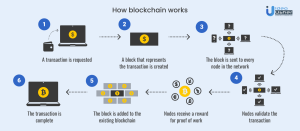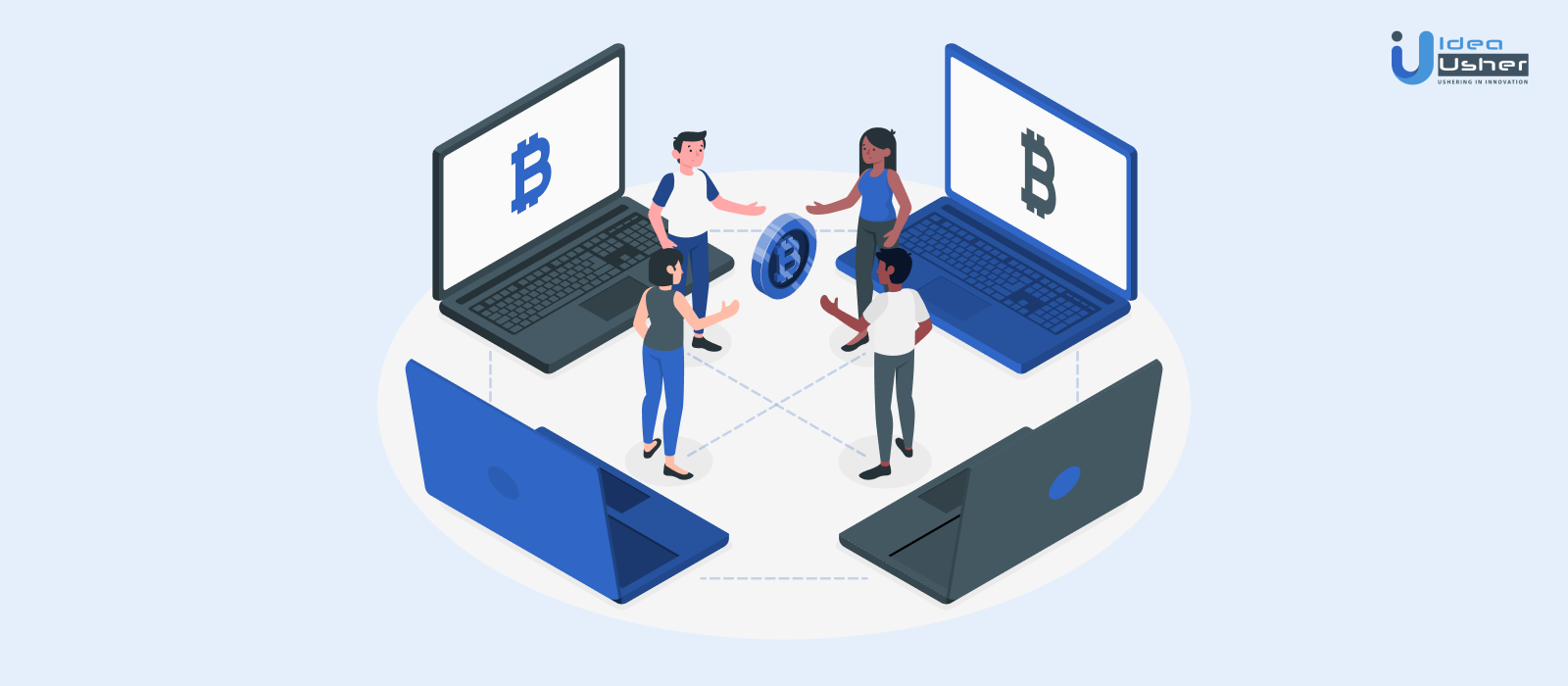Blockchain is a digital ledger that efficiently records transactions between two parties and verifies and permanent transactions. Every time a transaction occurs, it is updated in all of the ledgers stored across a network of computers. The chain of blocks is permanently linked to each other using cryptography. Blockchain can be used for many transactions, such as payments, contracts, agreements etc.
Blockchain was created for bitcoin, a form of digital currency, by someone using the pseudonym Satoshi Nakamoto. But it has evolved to be used for any exchange of data or assets. A block is a record of new transactions. The blockchain is a series of individual blocks linked together. Each link in the chain is a hash that connects to the previous one.
For example, it can be used to track ownership or help with supply chain management and ensure that a product can be traced back to its source if there is a food safety concern.

Also read; 51 Essential Blockchain Terms You Should Know
Key features of Blockchain that are making it so popular
Here are some of the key features of Blockchain that makes it popular;
Private key cryptography
In cryptography, a private key is secret information that allows you to sign messages and verify signatures. The corresponding public key is used to verify the signature but should be known to everyone.
The most common method of using a private key is to sign a message with it so that anyone can verify the message using the corresponding public key. In this case, only someone in possession of the private key can produce a valid signature.
Private keys are also used to generate session keys which are used to encrypt messages. Although messages encrypted with session keys can be decrypted by anyone who knows the public key, messages encrypted with a private key can only be solved by someone who has access to the private key; this is because only the holder of the private key can correctly generate the session keys which were used to encrypt them.
P2P Network
Peer-to-Peer (P2P) Network is an evolutionary development of the internet. A P2P Network is a computer network where participants connect directly to each other instead of through a central server. The advent of P2P Networks provides the required bandwidth for data sharing between users of any size, anywhere, anytime.
Theoretically, there are no limits to the number of users on a P2P network. It can be accessed from anywhere in the world without the need to log in with a username and password. Any peer can initiate a connection to share or download data with any other peer directly.
Blockchain program
A blockchain software is a distributed database that keeps a list of “blocks” that is constantly expanding. A date and a link to the preceding block are included in each block. It is the technology behind Bitcoin and other cryptocurrencies, but it can be used for so much more.
This network is decentralized and disintermediated. This means there’s no central authority governing the whole system – hence, no single point of failure. Since the system is distributed among peers, it’s also more transparent and secure, with no access restrictions.
Imagine if you had to wait for other drivers on the road every time you drove your car to verify that your car was working well. And imagine if they could change their minds and stop you at any time. That’s what it’s like today with traditional finance – only the other drivers are financial institutions and central authorities that regulate using antiquated and inefficient systems like paper contracts, bank transfers and databases.
Existing issues
Let us first see the existing issues in any system, and then we will see how blockchain technology helps us overcome these issues;
High transaction fees
Banks are making more money than ever off of their customers. A new report finds that fees on checking accounts have hit $30 billion over the past three years. Banks are finding sneaky new ways to get people to pay them, and consumers are largely powerless to do anything about it.
Banks are getting more creative regarding usurious practices like overdraft fees, which cost Americans $31.7 billion in 2016 alone. Some banks will charge you $35 for even the most basic overdrafts, while others will let you slide if you’re willing to pay a higher fee.
And, of course, there’s the infamous minimum balance fee. It’s one thing for a bank to charge an account-holder $15 or $20 per month if they don’t maintain a certain balance, but what happens if the balance is zero?
There are some ways to avoid fees on your checking account. You can find an account that waives all fees with no minimum balance or keep a small amount of cash in your account, so you’re never charged a fee at all. But overall, banking practices are only going to become more expensive in the future.
Double spending
Online banking systems are at a constant threat of being hacked; double-spend attacks are growing in popularity because they are less likely to be detected by banks or credit card companies.
A double-spending attack is when an attacker spends the same money twice. For example, suppose you have $10,000 in your checking account. The bank has set a maximum withdrawal amount of $400. A hacker could write a program that makes two requests to transfer $400 out of your checking account over the Internet. The bank’s computers process these two requests at roughly the same time. If one transfer request is approved but not the other, it appears to the hacker that he has succeeded in double spending his money.
Crisis and crashes
For the past few years, the global economy has been suffering from an ongoing banking crisis. Many national economies have experienced consistent economic growth over the past few decades. However, in 2008, the global financial crisis led to millions of people losing their jobs and savings. The problem also caused several major banks to collapse.
How is Blockchain overcoming the current issues?
We learnt about the already existing issues; now, let’s look at how Blockchain solves all the existing problems.
Decentralized power
One of the most significant features of blockchain technology is that it is decentralized. There is no single, centralized database or server. Instead, they are distributed across thousands of computers around the world. This network manages transactions collectively, which means that no one person or entity can control the information.
One of the main benefits of this decentralization is that it makes blockchains exceptionally secure. They are extremely difficult to break into because there is no central point for an attack to focus on. This makes them an attractive option for applications where security is paramount, such as money transfer and online voting systems.
Suggested read; What is Decentralized App Development or DApps? A beginner’s guide
Public ledger
A blockchain is a digital ledger in which bitcoin or other cryptocurrency transactions are chronologically and publicly recorded. A defining feature of a these digital ledgers is that no single party controls it. The technology is often referred to as a decentralized ledger.
A blockchain is a public ledger. It permanently records digital transactions, so they cannot be changed.
The idea of using cryptography to create digital ledgers was made long before the invention of bitcoin. Still, it wasn’t until 2009 that Satoshi Nakamoto — an alias for someone or some group — published the white paper describing the first peer-to-peer cryptocurrency. This system relies on a mathematical concept known as a hashing function to create unique identifiers for each transaction so that anyone can verify whether coins have been spent. Although bitcoins have gained attention because of their use in illicit transactions, the most important potential use of blockchain technology is its role as a distributed ledger for financial transactions.
Immutable
The distributed nature of Blockchain makes it virtually impossible to hack or corrupt. Because it is a decentralized network, its data is not controlled by a single entity. It can’t be held by a company, a hacker or even an entire government.
If anyone were to hack into a blockchain database and change something—say, add money to someone’s account—it wouldn’t take long before the rest of the digital ledgers would know that that transaction didn’t belong there. Every block in the chain would be updated to reflect the change. Because all of those blocks reference specific transactions in previous blocks, it would become immediately apparent which block was modified and by whom.
The only way to hack Blockchain is to hack every computer on the network at once. And because these networks have copies of their data in thousands of different places, that’s nearly impossible. To hack anyone’s block in a chain, you’d have to hack them all—and when you do the math on that possibility, it becomes clear just how secure this technology is.
Avoid double spending
Since all participants have access to the complete record of transactions, they can verify whether each transaction took place or not. Suppose someone tries to spend their Bitcoins to two different recipients at once, for example. In that case, the transaction will only go through if both parties are willing to accept it because everyone else will see their ledger copies and know there’s already another pending transaction for those coins.
Thus, double spending can never take place with blockchain technology.
Conclusion
The blockchain community is increasing. Nowadays, blockchain conferences are taking place all around the globe, and the number of interested people is rising. Like any platform, it’s still young and needs to be polished and improved. However, there’s no doubt that we’re on the brink of a technological revolution.
The next generation of these platforms will allow us to create services that we couldn’t imagine before. We’ll be able to carry out complex financial operations in a matter of seconds and make sure they’re transparent and secure due to also blockchain patent ecosystem is also in place.
Where to find skilled blockchain developers?
The awareness of cryptocurrency and its utility has been creeping up in the media. Businesses that miss out on this development will suffer from a competitive disadvantage.
In today’s business world, there is no time to waste. And many startups have not considered Blockchain as a possible tool for their business.
Idea Usher’s team of experienced consultants have developed a proven methodology to deliver a successful blockchain implementation with our Blockchain as a Service. Learn more about how you can partner with us to build a secure and trustworthy chain of software services for your business success now.
FAQs
Here are some frequently asked questions;
1. Is Blockchain and Bitcoin the same?
Blockchain technologies and Bitcoin are terms often used interchangeably, but they aren’t the same thing: Bitcoin is a type of digital crypto-currency. Bitcoin and other cryptocurrencies use blockchain technology to transfer funds directly from payer to payee with no need for a trusted third party such as a bank or financial institution. Every transaction is then recorded on a public ledger, known as a blockchain.
2. How many types of blockchain are there ?
There are several types of blockchain technology. Although these systems vary from one another, broad categories can be distinguished within the diversity. Most systems can be classified as public or private.
Public blockchains have an open membership and publicly verifiable transactions, while the private ones restrict access to authorized entities. Some blockchains use a combination of public and private membership. These types of blockchains belong to the emerging class of permissioned-variant technologies.
3. What is a smart contract?
A smart contract is a piece of code that is stored in the blockchain, which allows 2 or more parties to enter into an agreement regarding the use of an asset. These agreements are transparent, irreversible and independent of the intermediary.





















